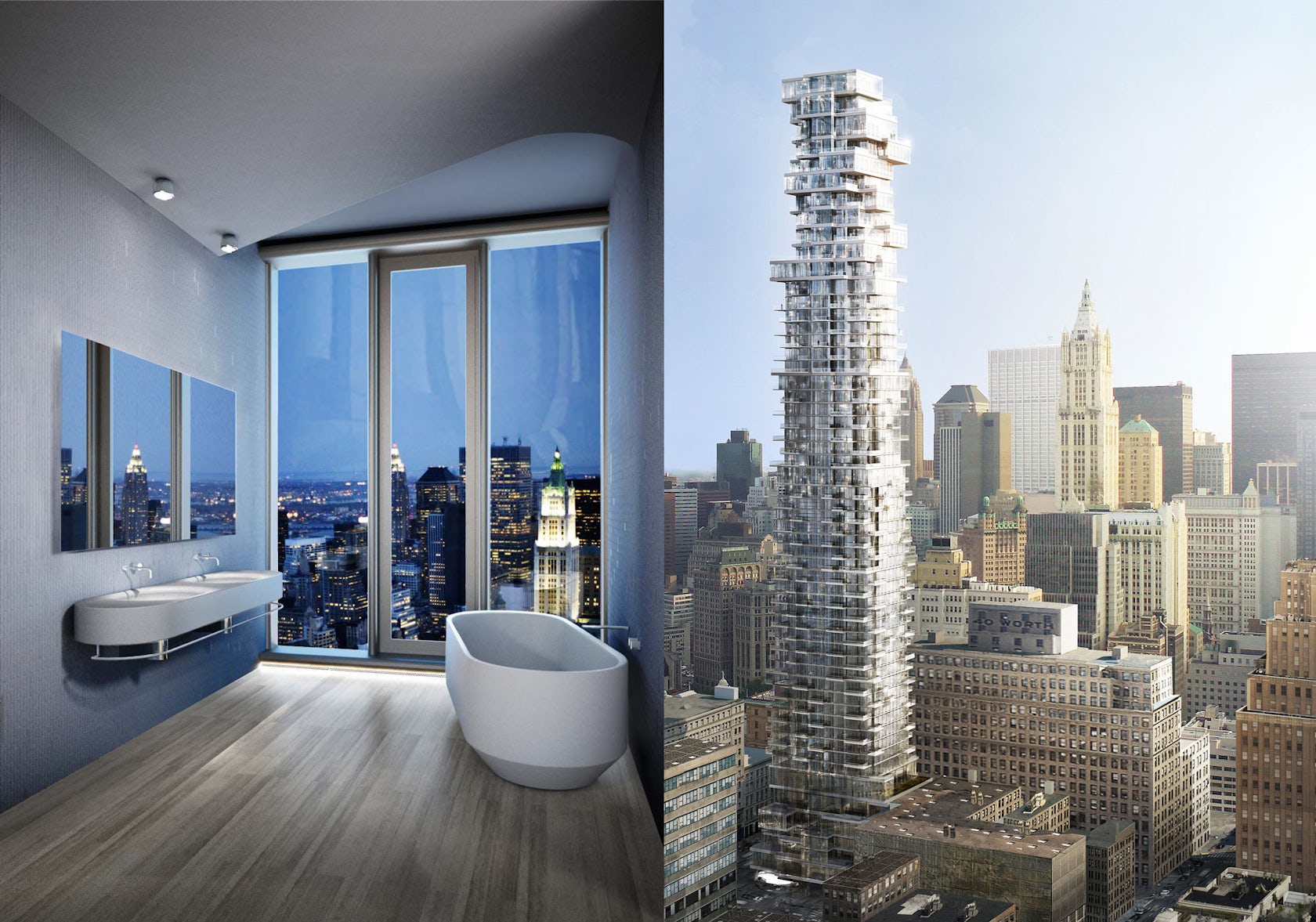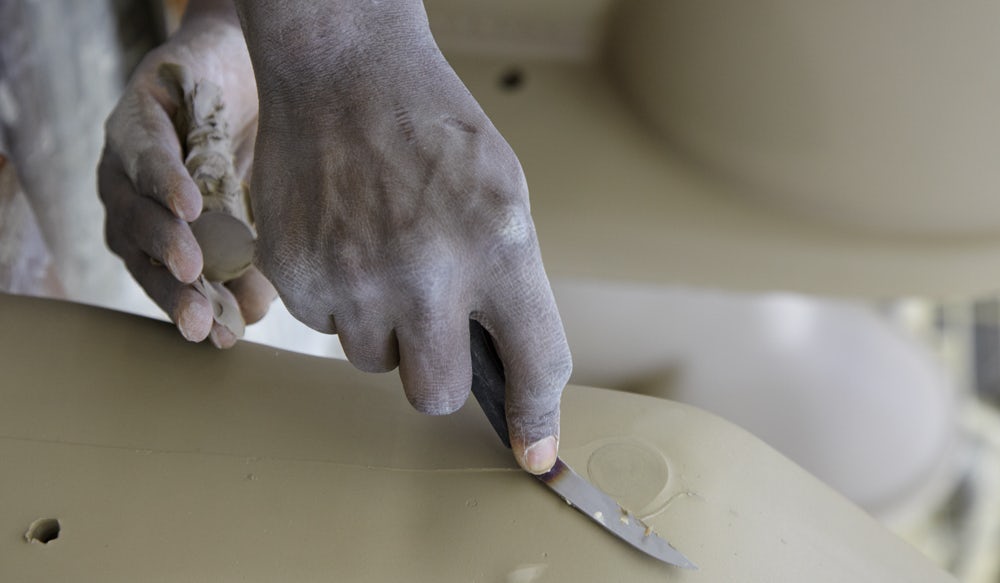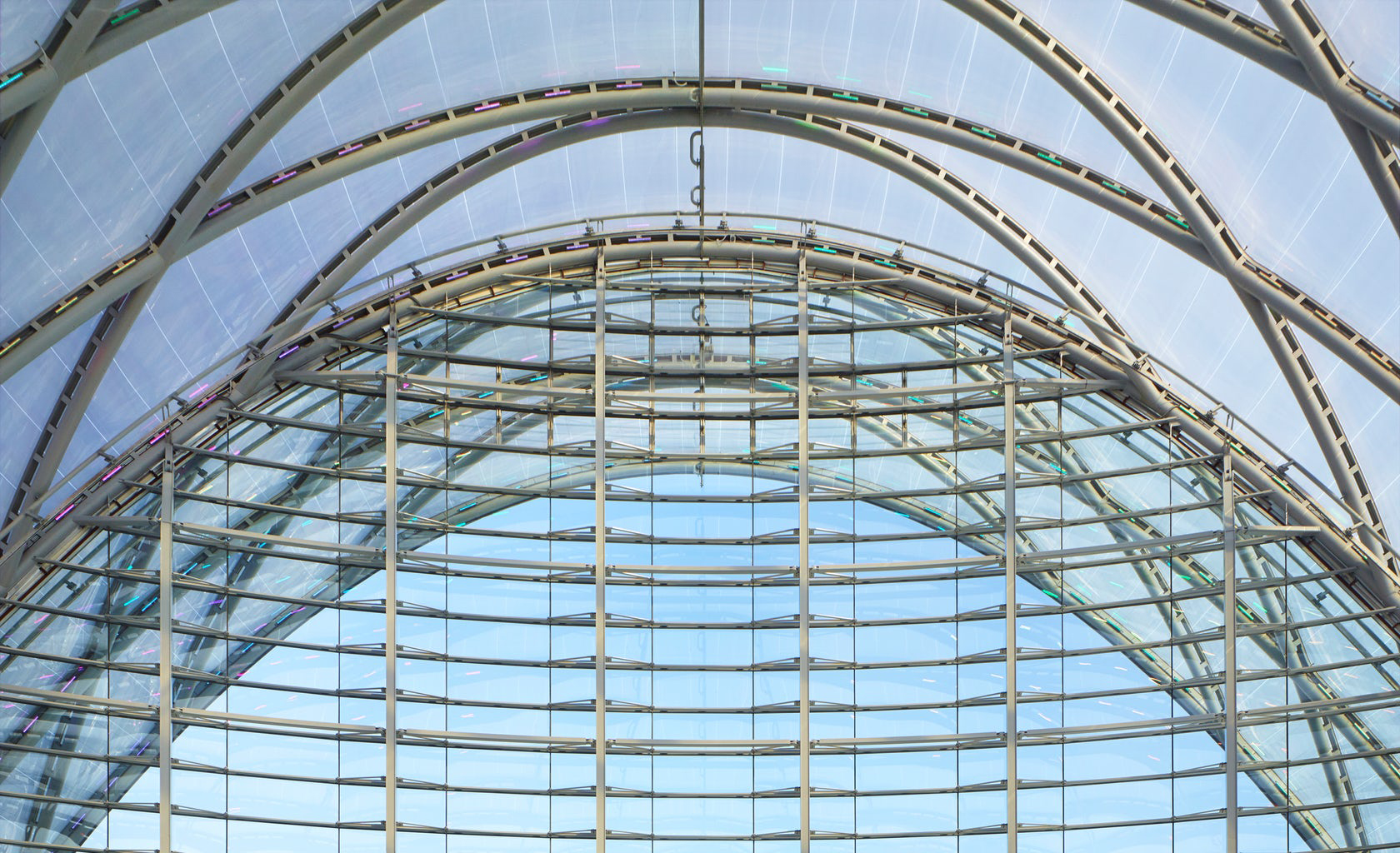In line with our new content direction, Architizer is highlighting a different building-product and how to specify it. Toilets are this week’s topic. If you’re looking for the perfect toilet for your next project, search for it on Architizer’s new network marketplace for building-products. Click here to see if you qualify. It’s free for architects.
Bathrooms can be a bit of a sticky wicket in high-end designs. Say you’ve spent months detailing and designing custom cabinetry, finding exotic finishes and doing the most to put your project over the top. But when it comes to the bathroom, it can be hard to know exactly how much you can do. Can you do a custom sink? What does a custom bath entail? And how about the toilet?

Left: renderings of a bathroom in 56 Leonard with custom bath and sink; right: rendering of 56 Leonard; images via LAUFEN
The development team behind 56 Leonard, the Herzog & de Meuron–designed luxury tower in New York City, knew that they wanted their project to have a bespoke bathroom experience from the start. Their solution was to enlist the Swiss ceramics manufacturer LAUFEN, a brand with over 120 years of experience creating bathroom furniture. The artisans at LAUFEN created “267 single washbasins, 144 double washbasins and 142 bathtubs designed by the architects as well as 577 toilets featuring a custom matte-white coating and imprinted with a special LAUFEN 56 logo” for the project, according to the company.

Mock-up bathroom in sales office of 56 Leonard with custom-finish toilet; image via Citi Habitats
The architects at Herzog & de Meuron designed baths and washbasins that repeated a pill-shaped motif used throughout the building. These were completely custom products designed specifically for 56 Leonard. The toilets, however, could not be completely custom. Ilker Hussein, Commercial Director at LAUFEN, explained that architects frequently design custom sinks and baths, but it is much more difficult and expensive to design a custom toilet because of the intense engineering involved:
“The science of flushing is very precise. The position and the angle of the bowl, and the bends within the design of the toilet, are really, really critical. This is why you find that bespoke and customization tends to be prevalent with washbasins, baths, shower drains, etc., but not necessarily with toilets.” He continued, “To actually develop the toilet, you are talking about hundreds of thousands of dollars compared with developing a washbasin, which could be the cost of the mold, and the mold could cost anywhere between $10,000 to $15,000.”
For more on the science of flushing, see our articles here and here.

The crafting of the custom bath products for 56 Leonard at LAUFEN

Firing of sinks and toilets in a LAUFEN kiln
LAUFEN was able to take one of their standard toilets and give it a custom matte-white finish for the project, but even that was not as straightforward as it might sound. In order to dull the high gloss of the standard finish, the toilets had to be fired a second time, which is an extremely risky process. “If you produce 10 toilets, you’ll probably get five or six out of the kiln [the second time] that are actually workable,” Hussein explained. The craftsmen at LAUFEN had to carefully manage the process in order to produce the toilets in large quantities.

One of the LAUFEN PRO toilets, the line that was used in 56 Leonard

One of the custom washbasins at 56 Leonard

The custom bath at 56 Leonard
While manufacturers can come out with new fixtures every few months or whenever their designers come up with a new form, toilet innovation is much more scientific. There’s not only the physics of flushing to perfect, but also the art of ceramic fabrication. “When you fire ceramic,” Hussein said, “it actually shrinks by 11 to 12 percent, but not evenly, so to create this perfect piece is a long, painstaking trial-and-error process to get right.”
LAUFEN’s carefully sculpted forms may seem like straightforward balls and cones, but an incredible amount of research goes into getting those lines to come out just right. If anything comes out slightly off, the whole toilet may be worthless. “Not only do you have to get the shape right,” Hussein explained, “but inside, the gradient of the pipework has to be so positioned that [if it is] just a couple of degrees out, … the toilet just won’t work.”

Mold for a custom sink for 56 Leonard

Hand finishing ceramics at LAUFEN
LAUFEN’s engineering extends beyond the form of the toilets and into the very stuff they are made out of. Ceramics are strong but brittle, and when they are thin, they can easily shatter. This means that ceramic products like sinks and baths generally have to be somewhat bulky so that they are strong enough to not break with daily use. For centuries, the makeup of ceramic has stayed the same, but Laufen is introducing a new innovation inspired by the craftsmanship of their country.
Hussein explained that what makes the glass on a top-quality Swiss watch so strong is a material called corundum. “Corundum is a derivative of sapphire. We have added elements of corundum into the ceramic … and this is what made the material stable for production. So when we were actually firing it in the kilns, it’s not deforming as much, and it’s very stable to be glazed. And that’s what makes the material thin and allows us to manipulate … the texture on the surface.”

Sonar sink with a thin, textured ceramic wall
This new super-thin ceramic has made impossibly delicate products possible. The thin ceramic can be punched and textured into new styles, an ability shown off in a new line from LAUFEN called Sonar designed by product designer Patricia Urquiola.
For the sinks and baths of 56 Leonard, LAUFEN used a solid surface they have developed called Sentec. Like other solid surfaces, this material may be cut after forming and may be more easily repaired than conventional ceramics. It’s also more easily available in a range of finishes and may be lighter than typical products.

LAUFEN manufacturing plant
Not every project has the budget for custom-finished toilets, and not every manufacturer can provide them. They are, admittedly, a very high-end option. But LAUFEN has a rich line of off-the-shelf products that make its high-quality craftsmanship available to a broader market. There aren’t many other places where you can work with second- and third-generation toilet artisans. “We’re the only European manufacturer of bathroom products that actually manufacture solely in Europe … We have two factories in Switzerland, two in Austria, two in Czech Republic and one in Poland.”

Hand crafting toilets at LAUFEN
This heritage is something the company is especially proud of and is especially valuable in the hand-sculpting of their products. Architects may take their products for granted, ignoring the careful skill that was required to make them. “If you look at our ranges, every range has a large, long basin,” Hussein pointed out. “To create a 6-foot basin, for example, heat it, and to have it finish straight, believe me, that is an amazing task.”
To find the perfect toilet for your next project, search on Source, Architizer’s new community marketplace for building-products. Click here to sign up now.




